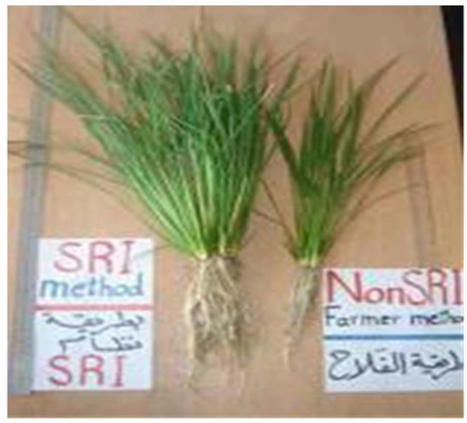This study evaluated what intervals of irrigation in conjunction with the use of SRI methods could achieve the greatest economic, as well as agronomic returns when growing irrigated rice under the water-deficit conditions of southern Iraq. A field study at the Al-Mishkhab Rice Research Station in southern Iraq recorded input and output data for three different irrigation regimes: continuous submergence of the rice crop; irrigation at 3-day intervals; and irrigation at 7-day intervals. Benefit–cost analysis showed 3-day intervals with SRI methods, giving the highest net returns and highest internal rate of return, indicating that the continuous irrigation of rice fields is a waste of water, with neither agronomic nor economic benefit. In Iraq, there are large opportunity costs for any unnecessary use of irrigation water. The highest water productivity was achieved with 7-day intervals of irrigation together with SRI methods, but this entails some sacrifice of the yield ha−1, as 13% less grain is produced than with continuous submergence of the crop. With 7-day intervals compared to 3-day intervals, water-saving was 44%, but compared to continuous submergence of the crop, the water-saving was 72%. This large amount of water could, if redeployed, enable many more farmers to cultivate larger areas of the land, increasing total rice production for Iraq.
Research and publish the best content.
Get Started for FREE
Sign up with Facebook Sign up with X
I don't have a Facebook or a X account
Already have an account: Login
 Your new post is loading... Your new post is loading...
 Your new post is loading... Your new post is loading...
|











Koop pillen om af te vallen
koop ozempic 0.25 mg
acquista saxenda
acquista subutex online
acquista ozempic
acquista qsymia
koop ozempic Amsterdam
koop ozempic Rotterdam
koop ozempic Eindhoven
mounjaro koop
zepbound koop
rybelsus koop
saxenda koop
wegovy koop
acquisto ozempic
ozempic prezzo
acquistare ozempic 0.5mg
acquistare ozempic senza ricetta
acquistare ozempic 1mg
ozempic comprar 1mg
comprar ozempic 1mg
ozempic comprar sin receta
ozempic comprar online
ozempic comprar
comprar ozempic 2mg
comprar mounjaro
kaufen ozempic Deutschland
kaufen ozempic
kaufen ozempic 0.25 mg
kaufen ozempic 0.5 mg
kaufen ozempic 1 mg
kaufen ozempic 2 mg
acheter ozempic
Acheter Ozempic 0.25 mg
Acheter Ozempic 0.25 mg MAINTENANT
Acheter Ozempic 0.5 mg MAINTENANT
ozempic perte de poid
acheter adipex p
acheter ozempic
acheter qsymia
acheter saxenda en ligne
https://ozempickopen.com/
https://ozempickopen.com/shop/
https://ozempickopen.com/product-categorie/weight-loss-medications/
https://ozempickopen.com/product/koop-ozempic-0-25mg/
https://ozempickopen.com/product/koop-ozempic-0-5mg/
https://ozempickopen.com/product/koop-ozempic-1mg-online/
https://ozempickopen.com/product/koop-ozempic-2mg-online/
https://ozempickopen.com/product/koop-adipex-online/
https://ozempickopen.com/product/mounjaro-kopen/
https://ozempickopen.com/product/saxenda-kopen/
https://ozempickopen.com/product/koop-wegovy-online/
https://ozempickopen.com/product/koop-zepbound-online/
https://ozempickopen.com/product/koop-rybelsus-online/
https://kaufenozemp25mg.com/
https://kaufenozemp25mg.com/geschaft/
https://kaufenozemp25mg.com/product/ozempic-kaufen-0-25mg/
https://kaufenozemp25mg.com/product/ozempic-kaufen-ohne-rezept-0-5-mg/
https://kaufenozemp25mg.com/product/ozempic-kaufen-schweiz-1mg/
https://kaufenozemp25mg.com/product/ozempic-kaufen-2mg-online/
https://ozempiccomprar1mg.com/
https://ozempiccomprar1mg.com/compra-ahora/
https://ozempiccomprar1mg.com/product/ozempic-comprar-sin-receta/
https://ozempiccomprar1mg.com/product/comprar-ozempic-online/
https://ozempiccomprar1mg.com/product/comprar-ozempic/
https://ozempiccomprar1mg.com/product/comprar-ozempic-2mg/
https://ozempiccomprar1mg.com/product/comprar-mounjaro-sin-receta/
https://acquistoozempic.com/
https://acquistoozempic.com/acquista-il-tuo-iniettabile-ozempic/
https://acquistoozempic.com/Prodotto/acquista-ozempic-0-25-mg/
https://acquistoozempic.com/Prodotto/acquisto-ozempic-senza-ricetta/
https://acquistoozempic.com/Prodotto/acquista-ozempic-1mg/
https://acquistoozempic.com/Prodotto/acquisto-ephedrine/
https://acquistoozempic.com/Prodotto/acquista-phentermine-online/
https://acquistoozempic.com/Prodotto/acquista-saxenda-online/
https://acquistoozempic.com/Prodotto/acquisto-wegovy-online/
https://acheteractiskenan.com/product/acheter-adipex-p/
https://acheteractiskenan.com/Produit/ozempic-sans-ordonnance/